
English porcelain sugar bowl, cover, and two Dutch Delft carafes
An English porcelain sugar bowl and cover circa 1820 and two Dutch Delft carafe's
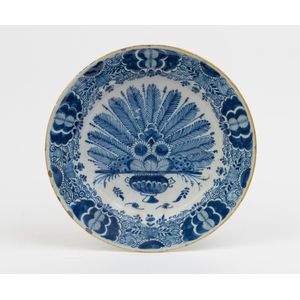
18th Century Dutch Delft Pottery Glazed Plate with Leaf Design
A Dutch Delft pottery glazed plate, 18th century, with a stiff leaf fan and vase decoration to the centre, frit marks to the edges and Delft marks underside, 26 cm diameter

Blue and White Delft Plates with Floral Design, 19th Century
Pair of blue and white Delft plates, Holland, 19th century, tin glazed earthenware with cobalt floral design at centre and band of blossoms around the edge, some visible chips (2), height 3.5 cm, diameter 22 cm. Provenance: Ben Stoner Antiques, Sydney
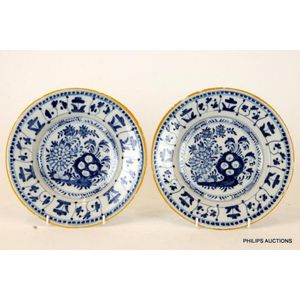
18th Century Delft Floral Plates
A pair of antique Delft plates, late 18th century, the pair of earthenware blue and white plates, each decorated with a rockery scene and floral spray to the cavetto, surrounded by freely painted floral borders, kiln spur marks to both, unmarked. Height 3…
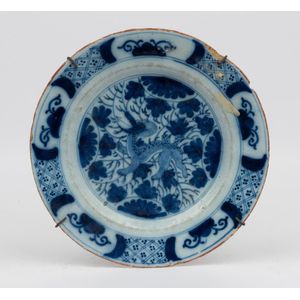
18th Century Dutch Kraak Style Delft Plate, 23cm
A Kraak style Delft plate, Dutch, 18th century, 23 cm diameter

English Pottery Plates and Dishes Collection
A collection of English pottery plates and dishes, including Delft, 18th century, comprising a pair of tin glazed plates with flowers in baskets; a Delft floral plate with a lavender powdered border, probably Bristol; a creamware plate with a red border,…

18th Century Dutch Delft Plate with Floral Design
Large 18th century Dutch Delft plate painted with flowers and butterfly, 36 cm diameter (rim flaws)
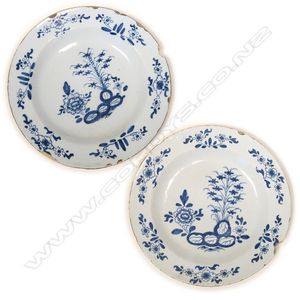
Delft Blue Floral Bowls, 35.5cm Diameter
A pair of large Delft blue, tin glaze shallow bowls, decorated with floral designs. Glaze fritting and chips to edges. Diameter 35.5 cm

Polychrome Chinoiserie Garden Dish
An English Delft polychrome dish, circa 1750, the large Bristol Delft polychrome pottery dish or charger, decorated with a bird perched on a trellis fence amongst foliage and flowers in a romantic Chinoiserie inspired garden setting covering the entire…

Georgian Delft Plate with Blossom and Garden Decoration
Georgian London Delft hand painted plate blossom and garden painted decoration, circa 1750, small rim chips, diameter 23 cm.

17th Century Delft Ware Jug and Bowl
Delft Ware, 17th century blue and white jug and bowl (some A/F)

Delft plates featuring Verveer's sailor and lady paintings
A pair of Delft, Holland plates, after paintings by Verveer, a sailor looking to his Beloved sea & a lady sewing, diameter 26 cm

Blue and White Delft Style Enamel Wall Clock, Mid-20th Century
A vintage blue and white enamel Delft style wall mount plate clock, early to mid 20th century, 27 cm diameter

Floral Delft Plate, Chinese Style (8 words)
English Delft plate with floral motif in the Chinese style, circa 1750, 23 cm diameter

Delft Blue Chinoiserie Soup Plate, 1760s
English Delft blue and white soup plate. Everted rim decorated with a bianco-sopra-bianco floral border. Cobalt overglaze Chinoiserie decoration of a man on a bridge, circa 1760-1770. Various rim chips and hairline cracks. Diameter 22.5 cm

Chinoiserie Peacock Plate, Delft Blue & White, Liverpool 1760
English Delft blue and white octagonal plate. Decorated in the Chinoiserie manner with a peacock in a landscape. Liverpool circa 1760. Some rim chips. Diameter 23.5 cm

London Delft Pottery Plates with Polychrome Geometric Patterns
Pair London Delft Pottery plates. Decorated with tin glazed polychrome traditional stylised geometric patterns, circa 1760. With minor rim chips and hairline cracks. Diameter 22.5 cm

Delft Blue Plate with Figure in Garden
Dutch 19th century Delft blue and white plate, of circular form, with slightly sloping sides, decorated with a figure standing in a garden holding a fan, surrounded by a stylised leaves. Signed Pk, diameter 23.5 cm
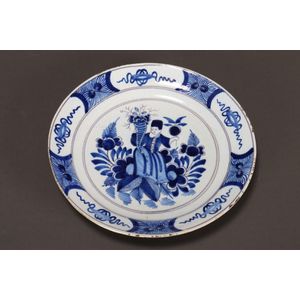
Delft Blue Lady Plate
Dutch 19th century Delft blue and white plate, of circular form, with slightly sloping sides, decorated with a central image of a lady holding a cornucopia of flowers, surrounded by a stylised leaf border, signed Apk verso, diameter 23 cm

Dutch Delft Bowl with Underglaze Blue Figures and Buildings
A rare Dutch Delft bowl and cover painted with figures and buildings in underglaze blue, circa 1750, 15 cm high, 12 cm diameter

Dutch Delft Blue Shallow Dish, 1760
A large Dutch Delft blue and white shallow dish, the decoration both in the central panel and the border of stylised flowers, berries and leaves. Dutch circa 1760. Diameter 36.5 cm. Provenance: The collection of Dr Trevor Hyde, Sydney

18th Century Delft Blue and White Platter
A Dutch delft blue and white platter, 18th century, with a central scene of houses by a lake and a single fisherman in the foreground, 33.5 cm diameter. Provenance: The Collection of the late Bjarne Nielsen

18th Century Dutch Delft Armorial Plate
A Dutch delft armorial plate, 18th century, 30 cm diameter. Provenance: The Collection of the late Bjarne Nielsen

18th Century Dutch Delft Polychrome Lobed Dish
A Dutch delft polychrome lobed dish, 18th century, decorated in yellow flowers, 34.5 cm diameter. Provenance: The Collection of the late Bjarne Nielsen

18th Century Royalist Charger with Crowned Figure
A Dutch delft polychrome royalist charger, 18th century, the lobed dish with centred by a crowned figure, 34.5 cm diameter. Provenance: The Collection of the late Bjarne Nielsen

18th Century Dutch Delft Plate with Chinese Interior Scene
A Dutch delft plate, 18th century, decorated to the centre with a Chinese Interior scene with figures, 23 cm diameter. Provenance: The Collection of the late Bjarne Nielsen

18th Century Dutch Delft Butter Dishes with Floral Motifs
A pair of Dutch delft covered butter dishes, 18th century, each painted with flowers throughout, the covers with moulded polychrome flower and leaf finials, 8 cm high. Provenance: The Collection of the late Bjarne Nielsen

18th Century Dutch Delft Butter Dish
A Dutch delft covered butter dish, 18th century, painted throughout with scrolling foliate strap work, 6.5 cm high. Provenance: The Collection of the late Bjarne Nielsen

18th Century Dutch Delft Liturgical Bowl, 40cm Diameter
A large and important Dutch delft liturgical bowl, 18th century, 40 cm diameter. Note: For a similar example see Christie's Pictorial History of European Pottery, by H. Morley-Fletcher and R. McIlroy, Phaidon, 1984, illustrated, p.221, no 24. Provenance:…

Delft Blue Floral Plate
19th century Delft blue and white porcelain plate depicting a vase with flowers, diameter 16 cm

18th Century English Delft Floral Punchbowl
An English Delft punchbowl, 18th century, the tin glazed earthenware bowl raised on a straight-sided foot rim, freely underglaze decorated with loose floral tendrils and part and whole flower heads executed with cross hatching and bold lines, height 10.5…

Delft Blue Flower Dish
A delft blue and white tin glaze shallow dish, decorated with a bowl of flowers, diameter 23.5 cm.

Dutch Delft February Calendar Plate, 18th Century
A Dutch Delft calendar plate, 18th century, the plate, titled 'February', decorated in blue with figures seated around table, some smoking church warden pipes. Bears mark 'Hs' to reverse. 24.5 cm diameter. Provenance: The John Scarce Collection of…

Dutch Delft Blue Flower Plates
Three Dutch Delft blue and white plates, decorated with a central panel of flowers and leaves surrounded by a border of lattice and stylised flowers. Dutch circa 1750. Diameter 23 cm

Delft Polychrome Dish with Caduceus Symbol
A Dutch Delft polychrome dish, shaped border decorated with flowers and scrolls containing a central caduceus symbol. Dutch 20th century. Diameter 28 cm

Els Boone Pottery Bowl from De Porceleyne Fles, Holland
Els Boone studio pottery bowl. From the 'Unica' Experimental Department of De Porceleyne Fles, Holland. Ex.the collection of Anneke Borren. Anneke worked at this studio in 1967/68, A.B: 'My time at the 'Unica' department, of the Royal Dutch Delft Blue,…

18th Century Delft Blue and White Plates
Two antique Delft plates, 18th century, tin glazed blue and white plates, one with five shaped reserves decorated, with freely painted formal flowers, the other with a scalloped central, reserve enclosing a water garden scene surrounded by circles…

18th C. Dutch Delft Polychrome Enamel Floral Plate
A late 18th century quality Dutch Delft polychrome enamel tin glaze plate, painted with various florals and insect, repeat patterned banded border, some fritting to edge, diameter 33.5 cm

18th Century Dutch Delft Cabinet Plate
A Dutch Delft cabinet plate, mid 18th century, 21 cm diameter

Blue and White Chinoiserie Delft Plate, 25.5 cm Diameter
A Delft tin glazed plate, decorated in blue and white with a chinoiserie design. Rim frits. Diameter 25.5 cm.

18th Century English Delft Blue & White Dish
An 18th century English delft large blue and white dish, the large floral highlights on a leafy decorated ground, some damage. Diameter 40.5 cm.

18th Century Delft Blue Chinese Garden Plates
A pair of Delft blue and white plates, mid 18th century, both depicting a Chinese figure in a fenced garden setting, a narrow diaper, border to the rim, a single blue underglaze mark, possibly the letter 'B, underside, diameter 23.5 cm

18th Century Delft Blue and White Deer Plate
A Delft blue and white plate, mid 18th century, the tin glazed plate decorated with a recumbent deer in a landscape, with, flora and fruits to the rim between concentric bands, diameter 23.5 cm

18th Century Dutch Delft Blue & White Peacock Dish
A Dutch Delft tin glazed blue and white dish, 18th century, traditional in design, having a large central peacock & floral design and geometric and foliate design to border, 4 cm high, 26.5 cm diameter,

Dutch Delft Blue Plate with Building and Birds
An 18th century Dutch Delft blue and white circular plate, painted with building, trees and birds. Diameter 23 cm.

Chinoiserie Blue Floral Delft Plates
Two 18th century English Delft plates painted in the chinoserie manner with blue florals

18th Century Delft Blue and White Dish
A Delft blue and white circular tin glazed dish, Dutch 18th century, 34 cm diameter

English Delft Blue Plate, 18th Century, 25cm Diameter
A English Delft blue and white plate, impressed mark IH, 18th century, 25 cm diameter
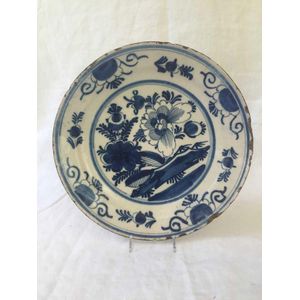
17th Century Dutch Delft Blue and White Plate
A Dutch Delft blue and white plate, 17th century, 22 cm diameter

17th Century Dutch Delft Blue & White Plates (2)
Two Dutch Delft blue and white plates, 17th century, largest: 23 cm diameter

18th Century Delft Plate with Floral Design
Early 18th century Delft plate, of circular form, decorated with a fence and flowers, surrounded by stylised floral border, diameter 30 cm

Strawberries and Delft Bowl
Gerrit De Jong, Still Life, Strawberries and Delft bowl, oil on canvas, signed, dated 1948. 18 x 26.5 cm

Dutch Delft Charger, Signed, Circa 1700
Dutch Delft tin glazed charger / bowl signed on verso by artist 'J.V.A. Circa 1700 (A/F), approx 31 cm dia

Flawed Antique Dishes and Repaired Imari Patterns
Three 17th and 18th century dishes, all with faults, a delft Chinese style tinglaze plate, and two Chinese Imari pattern dishes (both repaired). Largest diameter 24 cm

Delft Coastal Scene Plate with Gent and Dog
Antique tin glazed blue and white Delft plate, decorated with a gent and dog in a coastal scene with makers stamp to back, 25 cm diameter

18th Century Somerset English Delft Polychrome Plate
An English Delft polychrome decorated plate, Somerset origin, 18th century, 30 cm diameter

18th Century Delft Blue and White Plate (10 words)
An English Delft blue and white plate, 18th century, 30 cm diameter

18th Century Dutch Delft Plate, Blue and White
A blue and white Delft plate, probably Dutch, 18th century, 29.5 cm diameter

English Delftware Plate with Running Fox, 1736
A rare English running fox decorated delft plate, marked Prh and dated 1736, Lambeth or Bristol origin, 22 cm diameter, Note: Animals do not appear to have formed an important part of the delftware decorators' repertoire. When they do appear, they are…

Restored British Delft Plate with Fruit and Flowers
An antique British delft tin-glazed plate, decorated with fruit and flowers. Restored. Diameter 34 cm

Delft Blue Peacock Bowls
A pair of Dutch Delft underglaze blue chinoiserie shallow bowls decorated with the 'peacock' or 'fan' pattern, the design of flowers and fruit arranged to look like a peacock's tail, the border with alternating panels and with yellow rim, some rim frits.…

18th Century Delft Bowl in Ceramic Collectors Club Exhibition
Large 18th century Delft bowl, included in Ceramic Collectors club 1999 exhibition at Power House museum. As inspected

English Delft Plate with Bird & Pagoda Pattern
18th century English Delft plate, hand painted with bird & pagoda pattern

Blue Delft Plate with Fishing Scene and Sailing Vessel
A blue Delft plate, 1961, a limited edition plate 875/1000, 'Naar een schildery' by Jhb Koekoek 1840-1912, a traditional fishing by the shore scene with a sailing vessel and horse drawn cart, in underglaze blue with a shell form border; backstamps…

Delft Blue Weeping Tree Plates - Pair
A pair of Delft blue and white plates each decorated with a weeping tree the cavetto patterned with floral motifs, restoration present, 30.5 cm wide

18th Century Dutch Delft Plates with Chinoiserie Vignettes
A pair of 18th century Dutch Delft plates. Tin glaze blue and white with orange rims, each painted with Chinoiserie vignette of flowering shrubs, collection stickers verso, 29.5 cm diameter

18th Century Delft Plate Collection (3)
A collection of three Delft plates, 18th century, blue and white, variously marked, (3), 23 cm diameter. Provenance: Christie's, Melbourne, 29 March 1993, lot 120

English Delft Plate with Fence and Flowers
An English Delft plate painted with a fence, bamboo, flowers and an insect. Flowers to the border. a lavender hue to the ground. Bristol, Redcliffe backs, circa 1770. Width 22 cm

English Delft Chinoiserie Garden Plate, 1760
An English Delft plate with a lobed edge and painted to the centre with a Chinoiserie garden scene in a palette on greens, yellow, manganese and blue. Stilt marks under rim. Unmarked, circa 1760. Diameter 22 cm

18th/19th C. Delft Porcelain Plate, Blue Willow Pattern, Octagonal
Early Delft porcelain plate. Octagonal, blue & white willow pattern. Possibly 18th or early 19th century.length 37 cm

18th Century Delft and Bristol Plates from Arthur Lane Collection
Four English and Dutch Delft plates, 18th century, comprising two Dutch delft plates, one decorated in blue with the standing figure of a man, the other with a gentleman and a lady strolling through a wooded park, a Bristol plate decorated with a river…

Dutch Delft Dish with Running Hare and Tulips
A Dutch Delft dish, first half of 18th century, of moulded circular form, painted in under glaze blue and yellow with a running hare and a border of stylized tulips, 34 cm diameter. Provenance: Collection of the late Arthur Lane, Keeper of the Department…

1750 English Delft Plate with Peacock and Trees
An English Delft plate, circa 1750 boldly painted with peacock near trees and water in tones of blue, purple, yellow and orange, 22.8 cm diameter
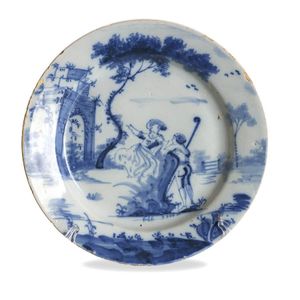
Bristol Delft Plate, Lady and Man Under Tree
A Bristol Delft plate, circa 1740 painted in blue with lady and man with shepherd's crook under a tree beside a ruined arch, artist, possibly Michael Edkins at Joseph FLower's Pottery, 22.5 cm. Reference: Poutney J.W. Arrorwsmith, Old Bristol Potteries,…

Lambeth Delft Plate with Parrot and Floral Border
A Lambeth Delft plate, circa 1740 possibly made and decorated by Thomas and Hugh Taylor and Richard Riley at their pottery at Redcliffe, Bristol, painted with a central roundel of a parrot on a branch by a cliff with flowering branches within a floral…

English Delft Shallow Dish with Floral Border
An English Delft shallow dish, circa 1740 possibly by Redcliff Back of Richard Franks factory Bristol, decorated with central floral spray within a swagged floral border in tones of blue, green, rust, yellow and green, 33.5 cm diam

English Delft plates with coronation & Chinese designs
Five English Delft plates, circa 1690-1760 including a coronation plate with crowned bust of William III with two tulips in blues, green and yellows, a Bristol Delft plate in Chinese design of man with fan under a tree within a panelled brocade border,…

English Delft Plates, 1740-1760
Four English Delft plates, circa 1740, 1760 comprising a Bristol Delft dish with birds and flowers and sprinkled manganese border, possibly William Griffith, Lambeth High Street, a pair of plates with floral decoration in red, blue and green, one restored…

English Delft Plates, Circa 1740 (Title is already provided)
Two English Delft plates, circa 1740 comprising a Bristol Delft plate with a central roundel of a demure swan in blue and green within a diamond banded border and a Lambeth Delft plate with central sunburst roundel in polychrome, 23.4 cm and 29.5 cm…

English Delft Plates, Circa 1750 (Set of 3)
Three English Delft plates, circa 1750 including a Bristol Delft plate 'bianca sopra bianco' with Chinese style scene of fishermen in blue and white, another with crested bird beside river in blue yellow and purple and a shell shaped bleeding bowl with…

English Delft Plates, 18th Century
Three English Delft plates, circa 1750, 1760 and 1740 including one with huntsman, barking dog and swallow tail bird with house in blue and white, another with floral decoration in polychrome and another plate with house and river scene in blue and white,…

English Delft Plates, 1760
Two English Delft plates, circa 1760 the one with cock, vase and flowers in blue, rust, yellow and green, the other with central roundel of a cottage scene within a leafy border and outer border of sprouting gourds in shades of blue, 22.5 cm diam, 21.2 cm…

English Delft Plate with Floral Border, 1760
An English Delft plate, circa 1760 possibly Liverpool, painted with central floral spray within panelled floral border in tones of blue, rust, purple and yellow, 34.2 cm diameter. Provenance: Collection of Jenny Douglas(Lal) Dashwood(1883-1957, Bromley UK…

English Delft Dish with Chinese Lady in Garden
An English Delft shallow dish, circa 1730 Bristol or London, painted with a Chinese lady in a pavilion in a garden within a panelled border of flowers and brocade in blue, possibly painted by John Bowen, 33.2 cm diameter. Provenance: Collection of Jenny…

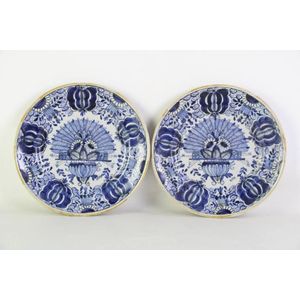





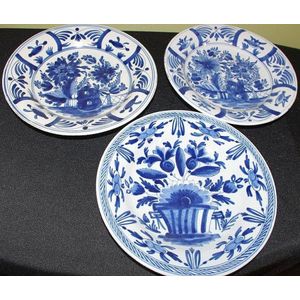
 Loading more...
Loading more...